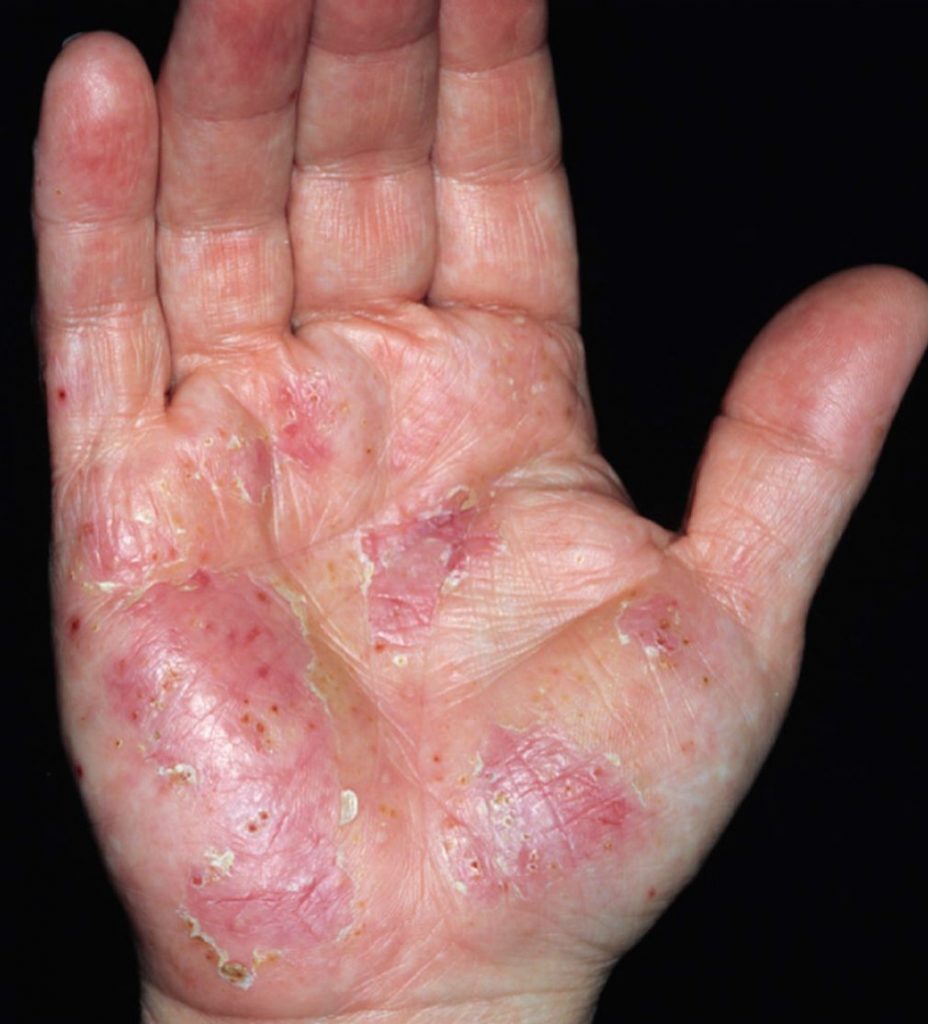Also known as … Dyshidrotic Eczema or Vesicular Eczema of Palms and Soles
What is Pompholyx?
Pompholyx is an often recurrent and frequently extremely itchy disorder characterised by tiny blisters and bumps on the sides of fingers, toes, palms and soles.
The cause of pompholyx is unknown. Pompholyx is considered a localised reaction pattern seen in other forms of dermatitis such as atopic dermatitis and allergic and irritant contact dermatitis.
Pompholyx is characterised by the sudden onset of crops of symmetric, firm, deep-seated tiny blisters on the palms, sides of fingers and less often on the soles and toes. These may aggregate and form larger blisters.
Intense itch and/or burning sensation usually precede the eruption. The attack can subside spontaneously over weeks to months. It is often recurrent.

A Color Guide to Diagnosis and Therapy
SEVENTH EDITION James G.H. Dinulos, MD
In long-standing cases, the individual’s fingernails may discolour or develop ridges.
Occasionally a bacterial infection, cellulitis or lymphangitis may develop.
Diagnosis of the pompholyx reaction pattern is based on a clinical examination of the hands and feet. A detailed history and wider clinical examination of the skin is needed in order to rule out an associated condition and guide further investigations.
The following associated conditions should be considered:
• Atopic eczema
o May be a late stage reaction and there may not be many other signs of dermatitis. History of past dermatitis is relevant.
• Contact dermatitis
Allergic contact dermatitis – nickel, cobalt, chromium and cosmetics have all been associated with a pompholyx reaction. Patch testing may be required.
• Irritant contact dermatitis has also been associated with pompholyx.
• Infections
o Inflammatory fungal infections may be associated with an id or pompholyx like reaction.
o Examination and investigations for evidence of bacterial or fungal infection may be required.
• Stress can be associated with a worsening of the pompholyx.
• Pompholyx has been associated with some immune system modifying agents.
• Hyperhidrosis of hands and feet may be associated with an increased likelihood of contact dermatitis and fungal infections that may trigger the pompholyx reaction.
Pompholyx may be difficult to treat. It is important to treat an associated condition, if present.
General advice:
• Avoid contact with irritants or allergens
• Use bland unscented moisturisers or just plain water, to clean hands
• Wear protective gloves in everyday activities
• Stop smoking
• Apply bland moisturisers frequently
Topical therapy:
The cornerstone of topical therapy is high-strength cortisone creams that may be applied
with wet wraps or cling wrap to increase their effectiveness. Other anti-inflammatory
creams such as calcineurin inhibitors can also be effective.
Management of bullae or blisters:
Blisters can be managed with compresses soaked in a very light pink solution of potassium permanganate or Burrow’s solution (10% aluminium acetate solution diluted to 1:40). Large blisters can be aspirated (pierced with a sterile needle).
Oral medications:
A short course of oral anti-inflammatory medication such as prednisolone may be required in severe flare-ups of pompholyx.
For severe, recalcitrant and chronic cases, corticosteroids may be combined with other immunosuppressants such as azathioprine, methotrexate, mycophenolate mofetil and cyclosporin.
Antihistamines can be helpful in treating the associated itch in some people.
Phototherapy and photochemotherapy
Variable effects have been reported using topical PUVA, oral PUVA or narrowband UVB to help control the inflammation.
This information has been written by Dr Davin Lim and Dr Heba Jibreal
Disclaimer
2019 © Australasian College of Dermatologists.
You may use for personal use only. Please refer to our disclaimer.